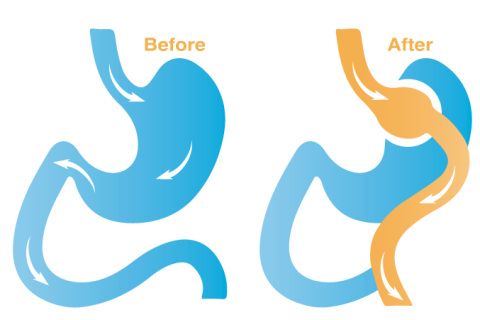When you are looking for a proven solution to severe obesity and related health issues, gastric bypass surgery offers a powerful tool for long-term weight loss and improved quality of life. Our program combines expert surgical care with comprehensive support to ensure your journey is safe and successful.
GASTRIC BYPASS SURGERY

GASTRIC BYPASS SURGERY
Gastric bypass surgery involves creating a small stomach pouch and rerouting the small intestine to it. This reduces the amount of food you can eat and decreases calorie absorption. It’s a highly effective procedure for weight loss and can improve conditions like diabetes, sleep apnea, and hypertension. Gastric bypass is ideal for those seeking significant, long-term weight loss.
Gastric Sleeve Package Cost $4599 USD
Transform Your Health with Gastric Bypass in Tijuana Mexico
- Gastric bypass is a patient-centered procedure designed to reduce stomach size and reroute digestion, helping you feel satisfied with smaller portions.
- We are your partner in health, guiding you through each stage of your transformation with nutrition, counseling, and medical expertise. healthcare to your door.
- The procedure provides effective, lasting results for significant weight loss, diabetes improvement, and reduced risk of obesity-related conditions.
Gastric Bypass Surgery in Tijuana Mexico With Dr. Arturo Figueroa
1. Candidacy and Application
To begin, patients must first be evaluated to ensure they are good candidates for gastric bypass surgery. Please complete our Surgery Approval Form. This allows our medical team to learn more about your health history and determine if you can be cleared for surgery.
2. Reservation and Deposit
Once you are approved and all information has been carefully reviewed, the next step is to secure your surgery date. A deposit of $460 USD is required to reserve your spot. This amount will be fully applied toward your surgery balance.
3. Travel and Final Payment
Patients are asked to send their flight information via email so that our team can arrange airport pickup and local transportation. The remaining balance is paid in cash at the hospital upon arrival. All instructions and detailed information will be provided to you by email well in advance of your procedure.
Who is a Good Candidate for Gastric Bypass Surgery
Gastric bypass surgery is recommended for individuals living with severe obesity who have not achieved lasting results through diet, exercise, or medical treatments. In general, candidates include those with a body mass index (BMI) of 40 or higher, or a BMI of 35 or higher when combined with serious obesity-related health conditions such as type 2 diabetes, high blood pressure, sleep apnea, or heart disease.
Beyond medical criteria, candidates should be committed to long-term lifestyle changes. Successful outcomes depend on maintaining healthy eating habits, regular physical activity, and attending follow-up medical care to monitor progress and nutritional needs.
How the Procedure is Performed
Gastric bypass is usually performed laparoscopically, using small incisions and specialized instruments to minimize recovery time. During the operation, the surgeon first creates a small pouch at the top of the stomach, reducing the stomach’s capacity to about the size of an egg. This pouch restricts how much food can be eaten in one sitting.
Next, the small intestine is divided, and the lower section is connected directly to the new stomach pouch. This allows food to bypass the majority of the stomach and the first part of the small intestine. Further along, the bypassed section of the intestine is reconnected so digestive juices can mix with food, ensuring that nutrients are still absorbed, though along a shorter pathway.
The end result is a smaller stomach and a rerouted digestive system. Patients feel full sooner, eat less, and absorb fewer calories. Over time, this leads to substantial weight loss and significant improvement or resolution of many obesity-related conditions.
Gastric Bypass Process at the Hospital
Arrival – One Day Before Surgery
When you arrive at San Diego International Airport, our designated driver will be there to greet you and transport you to our facilities. Upon arrival, you and your companion (if applicable) will be checked into comfortable accommodations for the night. Each room is equipped with a private bathroom, heating and air conditioning, Wi-Fi, and all the necessities to ensure your comfort and preparation for surgery the following day.
Surgery Day
Your hospital process begins at 7:00 am with pre-operative testing. Our internal medicine doctor will perform an EKG and collect blood samples for laboratory review. Once your results are cleared, you will be prepared for surgery. Before entering the operating room, you will meet Dr. Figueroa and his surgical team. This is your opportunity to ask any final questions and receive a detailed explanation of the procedure and what to expect.
During Gastric Bypass Surgery
All procedures performed by Dr. Figueroa are done laparoscopically, using small incisions in the abdomen for faster recovery and minimal scarring.
The surgery begins with creating a small pouch at the top of the stomach, about the size of a walnut, which can hold only a few ounces of food. This pouch is separated from the rest of the stomach. The small intestine is then divided, and a portion of it is attached directly to the pouch. This allows food to bypass most of the stomach and the first section of the small intestine, entering further along the digestive tract.
The procedure typically takes 90 minutes to 2 hours. After surgery, you will recover in a monitored environment where the medical staff ensures your safety and comfort.
Preparing for Gastric Bypass Surgery
Medical Evaluation
Before surgery, patients undergo a full medical assessment. This often includes blood tests, imaging, EKG, and sometimes an endoscopy. Your surgeon and medical team use this information to ensure you are medically fit for surgery and to identify any conditions that need to be managed first.
Nutritional Counseling
A dietitian will review your eating habits and help you begin lifestyle changes that are critical for long-term success. This includes portion control, balanced nutrition, and reducing high-sugar or high-fat foods.
Pre-Operative Diet
In the 1–2 weeks before surgery, most patients follow a special diet to reduce liver size and make surgery safer. This usually includes:
- High-protein shakes or meal replacements
- Lean protein sources such as fish, chicken, or tofu
- Non-starchy vegetables
- Limited carbohydrates and fats
- Plenty of water and clear fluids
Sugary drinks, alcohol, fried foods, and high-carb items are usually eliminated completely during this time.
Supplements
Since gastric bypass affects nutrient absorption, patients are typically started on supplements before surgery to build up healthy levels. Common recommendations include:
- Multivitamin with iron
- Calcium citrate with vitamin D
- Vitamin B12
- Sometimes additional folic acid or iron if levels are low
Lifestyle Adjustments
- Stop smoking at least 4–6 weeks prior, as it increases the risk of complications.
- Avoid alcohol before surgery.
- Begin regular, light exercise (walking, stretching) if approved by your doctor.
- Practice mindful eating: eat slowly, chew food thoroughly, and stop when full.
Medication Management
Your surgeon may adjust or stop certain medications (such as blood thinners, diabetes medications, or NSAIDs) before surgery. Always follow the medical team’s specific instructions.
Day Before Surgery
Most patients are asked to switch to clear liquids only, and then to fast after midnight before surgery. Detailed instructions are given to ensure a safe procedure.
Gastric Bypass Surgery Benefits
Celebrities Who’ve Openly Shared Their Gastric Bypass Journeys
Several well-known figures have courageously shared their experiences with weight-loss surgery—helping destigmatize the decision and offering real hope to others. Here are a few who have spoken publicly:
Al Roker
The beloved TV weather anchor underwent gastric bypass surgery in 2002 after struggling with his weight and a diabetes diagnosis. He lost over 100 pounds and has been candid about his ongoing journey with portion control and “food addiction.”New York PostWikipedia
Randy Jackson
The former American Idol judge opted for gastric bypass surgery in 2003 when diagnosed with type 2 diabetes. He lost approximately 100 pounds, adopted healthier habits, and later shared his struggles in a memoir.Pivot weight lossBodEvolve Bariatric Surgery CenterHealthCentral
Star Jones
Star, a television personality and attorney, revealed she had gastric bypass surgery in 2003. The procedure resulted in a loss of around 160 pounds, marking a profound transformation in her health and career.Pivot weight lossWikipedia
Roseanne Barr
The sitcom star underwent gastric bypass surgery in 1998 when her weight reached 350 pounds. In the years since, she has maintained her weight loss and candidly addressed the journey and the emotional impact of the surgery.Pivot weight lossMexico Bariatric Center®mydestinationweightloss.com
Carnie Wilson
Singer from Wilson Phillips, Carnie opted for gastric bypass surgery in 1999 and followed up with Lap-Band surgery in 2012 to contend with regained weight. Her openness about addiction and emotional eating resonates widely.HealthCentralWikipedia
Rosie O’Donnell
After suffering a heart attack in 2012, Rosie decided to prioritize her health. In 2013, she underwent gastric sleeve surgery, reducing her stomach size and embarking on a life-changing health transformation.Pivot weight lossHealthCentral
Why Their Stories Matter
By sharing their journeys, these celebrities have helped:
- Normalize bariatric procedures as legitimate health interventions
- Highlight the personal commitment and resilience required post-surgery
- Foster open conversation around obesity and mental well-being
- Offer encouragement to others considering similar life-changing decisions
Please call (888) 349-4769
Or contact us via email form below
